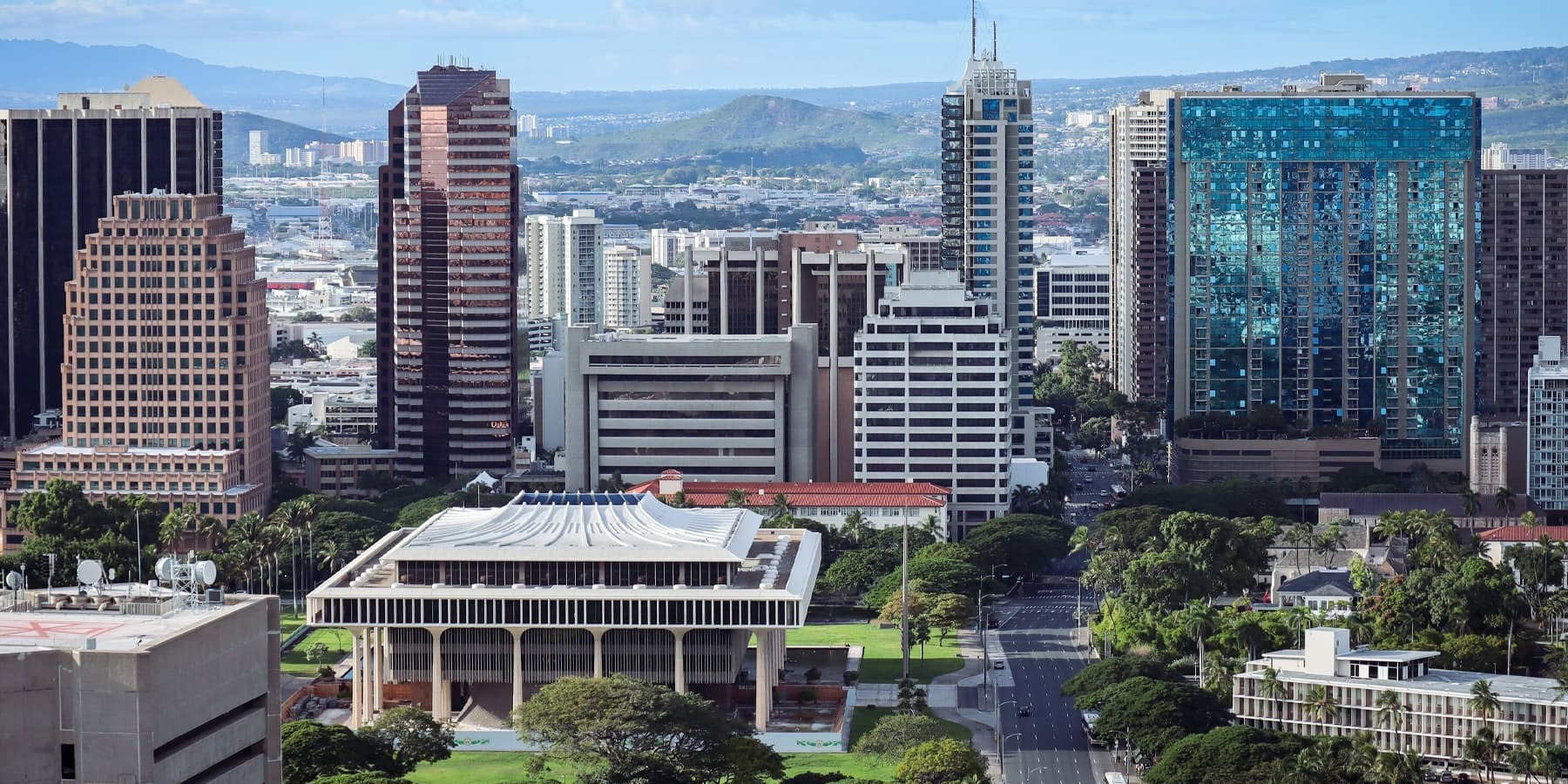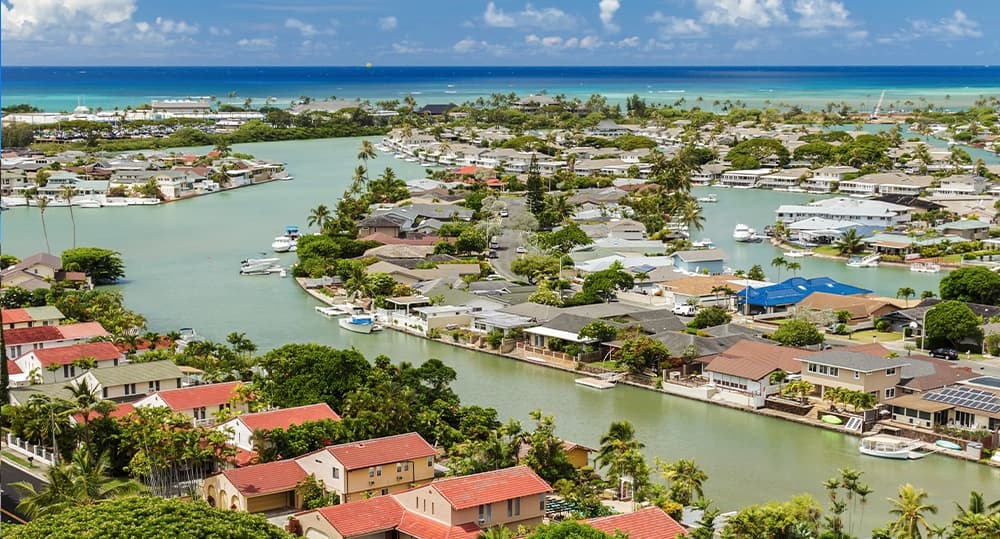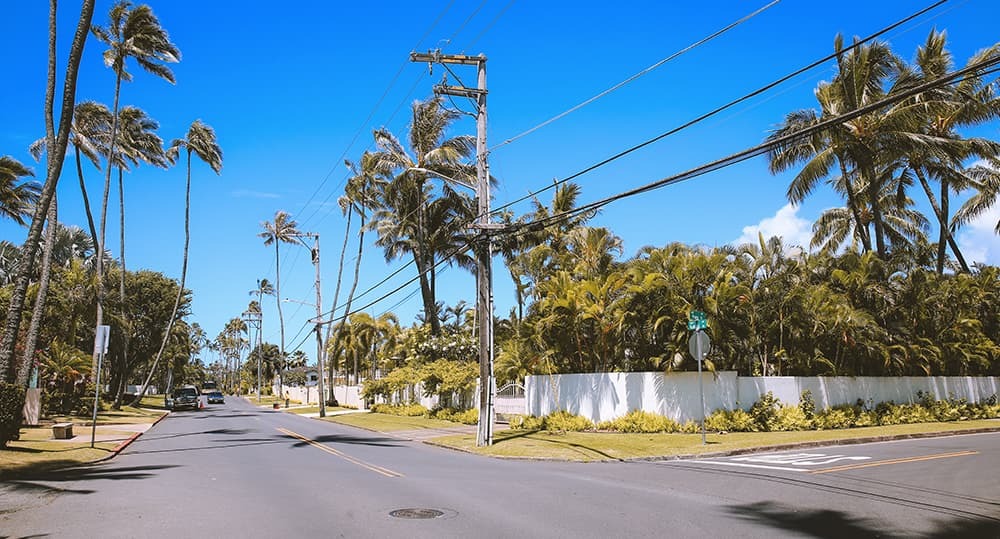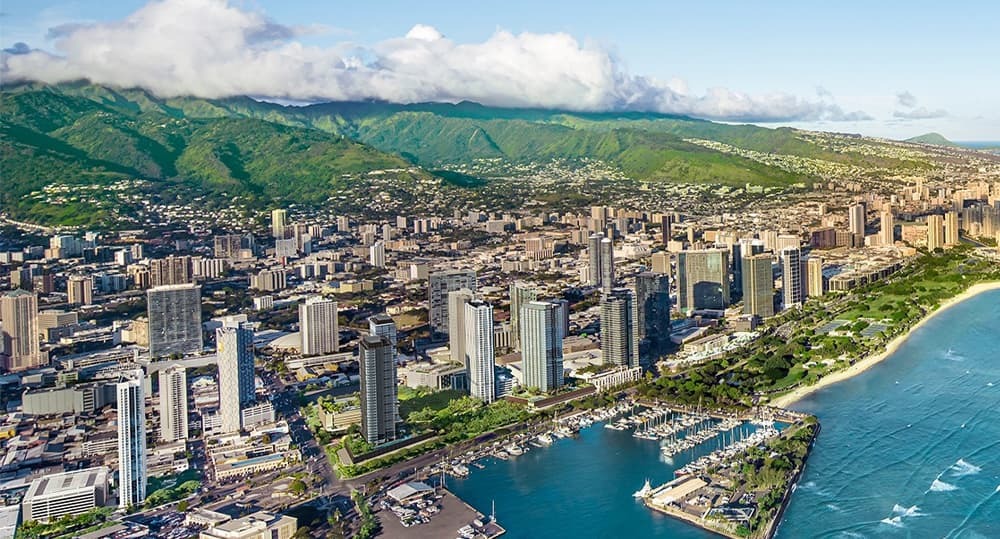Hawaii Kai Real Estate
A whopping 27 neighborhoods makes up the city of Hawaii Kai.
Honolulu homes come in a wide variety of styles and prices. While known for its luxury oceanfront estates, Honolulu has neighborhoods with affordable condos and modest homes for first-time buyers. Higher-priced inland homes on larger lots grace well-cared-for neighborhoods. As homes rise on hillsides, so do prices. Oceanfront luxury mansions and gated ridgeline estates with panoramic views are the most expensive homes in Honolulu.
Honolulu is a vibrant modern city with surviving reminders of a wonderfully storied past. The city has diverse climates and features, all within minutes of one another. From the coastal sun, surf, and powdery sand of the many beaches along the sparkling blue Pacific to hiking trails through lush hillside rainforests, from waterfalls cascading down valley mountainsides to a tropical fish wonderland carved out by a volcanic vent; this is beautiful Honolulu.
Marina homes with personal boat docks on inland waterways are just around the corner (around a crater, actually) from luxury homes tucked beside a golf course. Another golf course perched 400 ft. above sea level, flanked by lovely homes and towering valley walls, has stunning views of downtown Honolulu.
The Honolulu coastline from Hawai’i Kai to Diamond Head is home to exclusive sun-bathed homes and estates. However, valleys with houses of early or mid-20th century charm and hillside residences with cooler temperatures and scenic vistas occupy Honolulu’s mountain backdrop.
The entire island of Oahu is under the jurisdiction of the City and County of Honolulu; however, Oahu residents consider Honolulu as the neighborhoods with Honolulu postal addresses. This area includes East Honolulu, Urban Honolulu, and to the west end, a portion of Joint Base Pearl Harbor-Hickam.
Some of the most popular neighborhoods among the 40 or so in Honolulu include Hawai’i Kai, Hawai’i Loa Ridge, Kahala, Kaimuki, Waikiki, Manoa, and Tantalus.
Hawai’i Kai offers the marina lifestyle with single-family homes and townhouses on waterways. The original marina homes were the popular mid-century, low-ceiling, single-story homes. Many today have been renovated or remodeled. The marina has a little over 1,200 homes on peninsulas and nearby. Townhouse and condominium communities are also a part of the marina, adding to the vitality and beauty of the area.
Farther inland, subdivisions and luxury homes travel up the slopes of the Ko’olau Mountains. Along Kalaniana’ole Hwy, a gated golf community, more luxury homes, and the exclusive Portlock estates along the ocean are all part of the residential variety that is Hawai’i Kai.
Traveling west, oceanfront properties and homes mauka (mountainside) of Kalaniana’ole Hwy. enjoy sunny weather in lovely neighborhoods. Many subdivisions occupy the valleys and hillsides, with hiking trails all around.
Between the lovely homes and quiet neighborhoods of Niu Valley and Wailupe Valley is the gated upscale community of Hawai’i Loa Ridge. Beginning in the 1980s, spacious lots were purchased to build designer homes with breathtaking views from Koko Head to Diamond Head and beyond. Over 500 homes with ocean views are on the ridge today, and occasionally, one of the few remaining vacant lots becomes available.
World-renowned for its luxurious living, Kahala is situated along the coastline, bordering the Waialae Country Club and sheltered by Diamond Head crater to the west. The small, exclusive Black Point ocean peninsula is adjacent to Kahala. These are older, quietly fashionable neighborhoods with mostly spacious lots and 20th-century or newer architectural home styles. The closer to the ocean, the more expensive the home is, which is the norm for residential areas along Honolulu’s coastline.
North of Diamond Head is the older neighborhood of Kaimuki. On its hilly terrain, Kaimuki retains its simple early and mid-century style. Unlike a subdivision, the early homes here were built on individual lots, and many reflect the popular cottage and plantation styles from the first half of the last century.
Waikiki is west of Diamond Head with small, older residential areas adjacent to Diamond Head. Across from historic Kapi’olani Park, the homes are more expensive than those across from the Ala Wai Golf Course and north of Diamond Head.
Waikiki is generally associated with its famous beach and high-rise hotels. Today, its Luxury Row shopping district is more about upscale fashion along and around Kalākaua Ave. than retaining its touristy Hawaiian charm of yesteryear. However, the Moana, Royal Hawaiian, and Hilton hotels, icons of a former approachable elegance and style, are still here. The largest concentration of condos in Honolulu and on Oahu is in Waikiki.
Mauka of Waikiki and the H-1 Freeway, Manoa homes harken back to earlier eras. Charming bungalows and cottages are on tranquil tree-lined streets. Mainland architectural styles popular with prominent Honolulu families in the early decades of the last century make Manoa rather unique. Several homes are on the historic homes registry.
Ranch, mid-century modern, and modified plantation-style homes are farther into the valley. Larger homes with commanding city views are built on the valley hillsides.
Elevated Tantalus, an extinct cinder cone, with lush tree- and plant-shrouded residences and winding, ascending roads, offers rainforest coolness. Urban Honolulu is just below but seems much farther away in this large, somewhat secluded enclave.
Some of the most recent residential development has been farther up the ridges of the Ko’olau Mountains and into the scenic valleys. In urban Honolulu, new luxury high-rise condominiums are being built, especially in the transforming Kakaako neighborhood. Ward Village has expanded beyond Ward Centre. A master plan for ten high-rise condos and pleasant outdoor green spaces complements the existing fashionable shops and restaurants. Some high-rise condos are completed, and units are now for sale. Ward Village condos are fee simple.
Ward Village in Kakaako will eventually include 4,500 condos.
This 41-story luxury tower will feature 41 floors with 545 units.
A reserved housing development surrounded by green space.
Aalii was intelligently designed to simplify urban living.
Ward Village's 10th tower will have unobstructed ocean views.
Koula, known for fusing luxury and nature, is Ward Village's 6th tower.
A mixed-use tower with Whole Foods Market on the 1st floor.
A well-designed luxury tower with an expansive amenity deck.
Inspired by Victoria Ward's vision of a lively family estate.
Ke Kilohana is a 43-story, 424-unit condo off of Ward Ave.
A skyscraper architectural marvel, Waiea is elevating luxury.
A mixed-used 42-story building with ocean and city views.
A global branded luxury hotel with upper-floor residences.
Sky Ala Moana consists of 2 towers - Sky West and Sky East.
A twin-tower mixed-use development located near Ala Moana.
41-story, 408-condo project with one- to three- bedroom units.
A walkable hip community embedded deeply in Hawaiian culture.
Waiakoa will include 2 towers with 1,032 units in Our Kakaako.
Kahuina will offer affordable, workforce, & market rate housing.
Our Kakaako's newest project includes 292 market-priced condos.
The Collection, built in 2016 in Our Kakaako, is now on resale.
Keauhou Place is made up of 388 condo units & 35 townhomes.
400 Keawe is a 6 story mixed-use development in Our Kakaako.
A luxury, pet-friendly, eco-friendly development with 2 towers.
Kuilei Place is an approved development in Moiliili, Honolulu.
Park Lane Ala Moana is a luxury condo in Midtown Ala Moana.
Waihonua is located between Ala Moana Mall and Ward Village.
Built in 2007, Moana Pacific has 2 towers with luxury amenities.
Hokua is Honolulu's first luxury high rise built in 2006.
Koolani is centrally located between Ala Moana and Ward Village.
Muse Honolulu is a transit-oriented project in near Ala Moana.
Pacifica Honolulu offers 492 condos with unique floor plans.
Launiu is a proposed mixed-use luxury tower with 486 condos.
The first of Honolulu’s Super Block by Ala Moana Shopping Center.
Nauru Tower is a 44-story building with 411 units built in 1992.
Hawaiki Tower has the perfect location across Ala Moana Center.
Mahana Ward Village will include 340 new market-priced condos.
Melia Ward Village will replace Ward Centre w/242 new condos.
Ilima Ward Village will offer spacious units w/2- to 5- bedrooms.
801 South Street consists of two towers totaling 1,045 units.
A luxury condo built in 2008 with a strong local community.
Royal Capitol Plaza is located in West Kakaako near to Downtown.
A mixed-use condo/townhouse development built in Kakaako in 1991.
Unique industrial-style designed lofts located in Kakaako.
Symphony Honolulu, built in 2016, has 45 floors with 388 units.
It will include 2 towers with residential & condo-hotel units.
Modea (Davies Pacific Center) will offer 352 new condos.
A new mixed-use development with 631 market & affordable units.
As a leasehold property, the buyer, in a sense, is renting the property. In addition to the cost of the condo, an agreed-upon annual or monthly lease amount is determined. At the end of the lease, usually 40-50 years, a new lease may be created, the lease discontinued and the property reverting to the leaseholder, or the option to buy the lease offered. Generally, a leasehold property is not as expensive as a comparable fee simple property. The buyer may be planning to sell the unit before the lease expires or may hope that an offer to buy the lease is given. A fee simple property is one in which a buyer purchases the condo.
Commercial and residential Honolulu began in the 1790s when an English sea captain and trader determined that the harbor of Honolulu was deep enough for ships. It became a seaport hub for whaling and sandalwood traders, and other ships plying the waters between East and West. The commercial area around the port grew, and as a result, merchants built homes and businesses.
The rich volcanic soil spawned agriculture, necessitating more port merchants and related commerce. With the agricultural expansion, especially in sugar cane and then pineapple, laborers came to the island, first from China and then Japan. Most workers stayed and eventually left the fields to find work or start businesses in Honolulu. Other Asian contract workers followed as previous workers ended their contracts.
Kamehameha conquered Oahu around the same time as the port discovery and in 1804 moved his court from Hawai’i (Big Island) to Waikiki. About 1810, Kamehameha moved from Waikiki to commercially thriving Honolulu. However, two years later, Kamehameha moved his court back to the Big Island.
Nevertheless, with its seaport the significant factor, Honolulu continued to grow. In 1850, it officially became the permanent capital of the ‘an Kingdom. The city continued as the capital of Hawai’i through the overthrow of the kingdom and statehood in 1959 and remains the capital today.
Statehood brought many more tourists and further economic growth. Only the more affluent could afford the passenger liners to Hawai’i in the early 20th century. However, tourism growth after statehood went hand-in-hand with advancements in aircraft design, making travel times shorter and aircraft passenger capacities larger. This growth in the industry created new jobs, and many curious visitors to Hawai’i decided to stay.
Housing developers responded to the growth, constructing subdivisions and planned communities. The city grew in both directions, east and west, and up mountain slopes and in valleys. Today, Honolulu extends along the coastline from Hawai’i Kai to parts of Hickam and Pearl Harbor in the west. The population in 2020 was around 351,000.
Oahu had passenger rail systems as late as 1947, but was eventually replaced by buses. A new rail system is under construction. The light metro rail trains will begin farther west on Oahu in the planned community of Kapolei, dubbed Oahu’s second city. The first city stop will be at the Makalapa entrance to Pearl Harbor Naval Base. Then, the trains will wind around to the airport and more city stops, eventually ending at Ala Moana Shopping Center. The project has had many delays; the expected fully operational date is now 2031.
The rail system is expected to be used to alleviate the vehicle congestion not limited to rush hour. In town, bicycle lanes and paths have been created for residents who wish to bicycle to work.
Honolulu’s culture is a potpourri of Asian, European, other global ethnic backgrounds, and, of course, Hawaiian. However, the culture also includes the many lifestyles that Hawai’i’s history, location, climate, topography, native species, and ocean environment afford. Cultural history, the arts, and live performances are just a few of the attractions in Honolulu. Significantly, Hawaiian heritage and sense of place thrive in all.
A stroll through the downtown business district displays architectural building styles popular in the 19th and early 20th centuries. The Hawai’i Historic Foundation provides a brochure online for a self-guided tour of 25 historic structures, including ‘Iolani Palace, the last home of Hawaiian Royalty, ending with Queen Lili’uokalani, and the Mission Houses and Museum, the oldest surviving Western structures in Hawai’i. The iconic Aloha Tower that greeted Matson cruise line passengers arriving in Hawai’i is nearby at the port of Honolulu.
A few blocks west of Bishop St. along King St. is Chinatown, with shops of oriental “treasures,” lei florists, and delicious local food. The Downtown Art Center, showcasing local art, and the arts district are also in this area. Nearby is The Hawai’i Theatre, a large restored ornate 1920s theatre presenting live performances and performing groups.
Honolulu has several museums. The Bishop Museum features the natural and cultural history of Hawai’i and includes a science center and planetarium. The Queen Emma Summer Palace exhibits the furnishings and antiquities of Kamehameha IV and Queen Emma. The Hawai’i State Art Museum displays the art of Hawai’i, and the culture of Hawai’i through the art.
The Honolulu Museum of Art has more than 38,000 works from all over the world. The Spalding House extension on Tantalus above the cityscape has an extensive collection of contemporary art. Near Diamond Head, at Black Point, is Doris Duke’s Shangri La Museum of Islamic Art, Culture & Design. Tours are arranged through the Honolulu Museum of Art.
The National Historical Landmark of Pearl Harbor has several WWII military-related exhibitions, including the Pearl Harbor Memorial Museum, the Arizona Memorial, the USS Bowfin Museum, the Battleship Missouri Memorial, and the Pearl Harbor Aviation Museum.
These are just a few of the many museums and galleries located in Honolulu. Lyon Arboretum, City Botanical Gardens, Manoa Heritage Center, Honolulu Zoo, Waikiki Aquarium, Diamond Head, this list is not exhaustive for all the attractions in Honolulu.
The historic Diamond Head Theatre regularly performs Broadway plays and musicals. The Manoa Valley Theatre does the same. The Neal S. Blaisdell Concert Hall features the Honolulu Symphony, Hawai’i Opera Theatre, popular performing artists, and Broadway touring companies. The outdoor Waikiki Shell in Kapi’olani Park hosts concerts with local, national, and international talent. Hawaiian music and hula performances can be heard and seen in Waikiki and at various venues around the city.
The average annual high temperatures in inland Honolulu are between 80°F (27°C) and 91°F (33°C). The average annual low temperatures are between 64°F (18°C) and 75°F (24°C). These averages are lower at higher elevations.
Especially along the coastline, Honolulu experiences almost 280 sunny days per year with many of the other days experiencing only brief showers. In the elevated and valley areas, rainfall is more frequent, but then rainbows are too!
Warm weather outdoor activities are almost endless. Waikiki Beach is the iconic beach of tourist brochures, but many other lovely beaches in Honolulu are tucked along the coastline from Ala Moana Park to East Honolulu.
With ocean temperatures between 75°F (24°C) and 80°F (27°C), Honolulu offers heaps of ocean sports activities for residents. Surfing is, of course, one of them, also fishing, boating, sailing, paddling, parasailing, skydiving, windsurfing, kiteboarding, kitesurfing, jet skiing, waterskiing, scuba diving, and snorkeling. Whew! And all of this is available within the city limits!
The whales in their annual migration from Alaska to Maui and back can be seen from the shores of Honolulu. From surfboards or sailboats, residents can see the whales close up; it is a spectacular sight. Imagine viewing a breaching whale from above while parasailing!
Hiking trails in Honolulu are many in the valleys and up the slopes of the Ko’olau Mountains, offering waterfalls and a distinctly different climate from the oceanfront. Runners and bicyclists can be seen on the quieter streets of Honolulu, especially in scenic areas along the coastline. In December, the Honolulu Marathon winds its way through Diamond Head, Kahala, and along Kalaniana’ole Hwy. and back.
For golfers, nine public, private, and military golf courses are within the Honolulu city limits, and more beyond. The PGA’s Sony Open is held annually at the Waialae Country Club in Kahala.
City parks are all over Honolulu, generally providing baseball diamonds, soccer fields, tennis/pickleball/basketball courts, and green spaces. There are also many pleasant neighborhood-maintained parks.
The school system consists of an elementary school (PK-5), intermediate school (6-8), and high school (9-12). Some districts rate more highly than others. There are also some public charter schools in the Department of Education system.
Several highly rated private and religious schools in Honolulu offer education from pre kindergarten through high school. Kamehameha Schools (K-12) is for students of Hawaiian ancestry.
The University of Hawai’i System operates two public community colleges in Honolulu and the four-year University of Hawai’i at Manoa. Chaminade University of Honolulu and Hawai’i Pacific University are two of the more prominent private colleges in the city.
Straub Medical Center, The Queen’s Medical Center, Kapi’olani Medical Center for Women and Children, and Shriners Children’s Hospital are all within minutes of any neighborhood in Honolulu via the H-1 Freeway.
On the western boundaries of Honolulu, Kaiser Permanente’s Moanalua Medical Center and Tripler Army Medical Center for military personnel, their dependents, and retirees are also accessible via the H-1 Freeway.
Ala Moana Shopping Center, Waikiki’s Kalākaua Avenue, and Kahala Mall are the three major shopping areas in Honolulu; however, several smaller shopping centers and malls are throughout the city, many with major mainland franchises.
A whopping 27 neighborhoods makes up the city of Hawaii Kai.
A mom-and-pop neighborhood evolving from historic to hip.
Newly built condos, microbreweries, hidden speakeasies, and more.
An iconic neighborhood known for its luxury oceanfront homes.
An older, charming neighborhood known for its quality schools.
Living in Waikiki is like being on vacation year-round.
A newly transformed suburban neighborhood with a local feel.
Hawaii’s first planned community, located in central Oahu.







